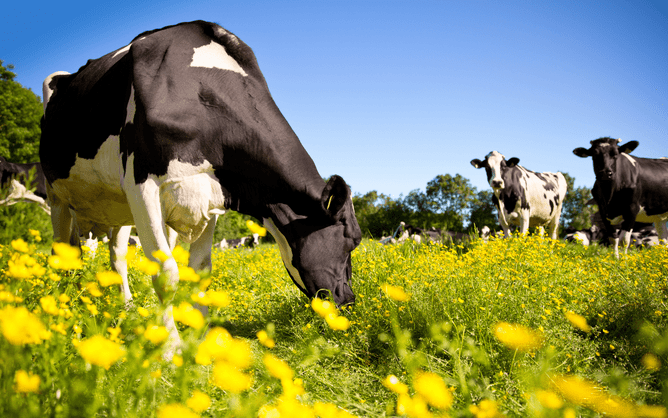Despite its name, facial eczema is primarily a liver disease, caused by cows eating lots of spores from the fungus Pithomyces chartarum, which grows in dead matter in pasture, in the right environmental conditions, in the summer.
Here in the Waikato, the facial eczema season can be from January to late April. Fungal growth can happen when temperatures rise above 12°C, but spore production is highest when the temperature is between 20-24°C. It occurs rapidly, 2-4 days after rain.
The spores require dead matter in the pasture, so paddocks with more mature flowering grasses and topped grass paddocks will be most at risk. Grazing lower residuals will increase the amount of dead matter the cattle will be consuming.
Symptoms
Symptoms of facial eczema in cattle can range from
Mild sunburn on teats,
White haired skin peeling,
Blood in the urine,
A drop in milk production,
Sudden death of the cattle, either in the acute phase or when they undergo periods of stress (such as calving).
Clinical signs are generally seen 1-2 weeks after the liver damage has occurred and we can only provide symptomatic care via shade, skin protection and liver support at this time. Liver damage can be measured with a blood test for the liver enzyme GGT.
One cow with clinical signs will usually equal 50-100 cows with unseen liver damage!
Liver damage can be very severe and, while sometimes the liver regrows, it is unlikely that the cow will ever completely recover and may relapse in the future.
Reducing the risk
Offer other sources of feed, such as meal, silage and other crops (e.g. chicory) over the summer to reduce the number of spores ingested from traditional pasture.
Fungicides can be used on the pasture, but it needs to be applied before spore counts rise, not when it rains. It also needs to be combined with spore counting, as, if spore counts rise, further spraying is ineffective for reducing them and the cows are unprotected against any outbreaks.
Breeding for resistance. In the 30 years the sheep industry has been breeding for resistance, it now needs to use 7x the dose of the toxin sporedesmin to cause liver damage. Bull testing is 20 years behind, but making progress. Breeding with selected bulls for facial eczema resistance helps cows develop less liver damage, with associated milk drop and clinical disease, than cows not being bred for it.
Doing weekly pasture spore counts over summer can help you to monitor when spore counts start rising, when preventative treatment is needed and what is happening in the pasture.
Zinc supplementation
Zinc is also commonly used for facial eczema prevention. However, supplementing with zinc may not always be an option, as zinc levels are increasing in the soil and high zinc levels are not good for microbial growth or plant growth.
Many farms use in-water zinc, but research has shown that it may not be effective. Approximately 60% of cows do not have adequate blood zinc levels for facial eczema control with in-water zinc.
This ties in with blood tests for liver damage in dairy cows (done in a year with lower spore counts and no clinical cases seen) showing that 33% of farms have increased enzymes and liver damage (with associated production loss).
Delivering zinc directly to the cattle either in-feed, with zinc boluses, or through oral drenching, can ensure the dose is effective.
When to use zinc
Zinc supplementation needs to be started a few days before high spore counts. A mixture of weekly spore testing your paddocks and watching the rain forecast may help with predicting when to start this, as well as keeping your pasture quality high going into the summer; not topping and not grazing too low.
Zinc toxicity in cattle is likely to occur when zinc is used for more than 12 weeks. Nowadays, the facial eczema season can be 14 weeks and toxicity may be more common, particularly in calves. Monitoring spore counts can ensure that treatment doesn’t start too early or too late.
Blood testing cows for zinc levels can also be useful, both early and late in the season, to ensure your supplementation method is providing effective levels for preventing facial eczema and that it has not reached toxic levels.
Using a combined approach, with breeding for facial eczema tolerance, pasture management, alternative feeds, spore counting and effective zinc supplementation with monitoring, can lead to more effective reduction in facial eczema risk, with associated reduced liver and clinical disease, improved milk production and bottom line!

